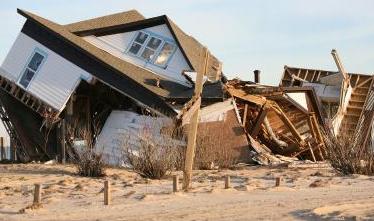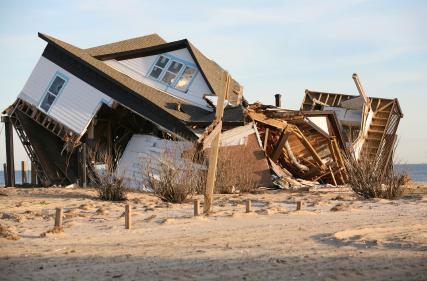 Survivors of Hurricane Sandy might have another battle on their hands when it comes to dealing with their insurance company.
Survivors of Hurricane Sandy might have another battle on their hands when it comes to dealing with their insurance company.
Hurricane Sandy could result in several hundred thousand claims for wind damage by homeowners, as well as tens of thousands of federal flood insurance claims, according to the Consumer Federation of America.
“Families should take every precaution to ensure their safety during this severe weather event, including evacuation if recommended by local authorities,” J. Robert Hunter, director of insurance for CFA and former federal insurance administrator and Texas insurance commissioner, said in a statement. “After the storm, however, we are concerned that families will have to dig deeper into their pockets because insurers have been steadily shifting liability to consumers by increasing hurricane wind coverage deductibles and imposing other policy limitations.”
According to the CFA, many consumers experienced claims problems in the wake of Hurricane Katrina and Irene, so homeowners dealing with losses caused by Hurricane Sandy should be vigilant with their insurance companies to ensure that that they receive a full and fair settlement.
As consumers prepare to contact their insurance companies in the wake of the storm, the CFA offers the following tips:
• Report a claim as promptly as possible as insurance companies generally handle them first come, first serve.
• Once a claim is reported, be sure to get the claim number and write it down. Insurance company claims departments can locate a file easiest by the claim number.
• When the insurance company sends out an adjuster to survey your damage, ask if they’re an employee of the insurance company or an independent adjuster hired by them. If an independent adjuster, try to secure the name of the actual company adjuster that the adjuster is sending your information to or if they’re authorized to make claim decisions and payments on behalf of the insurance company.
Keeping good records
When filing a claim, the CFA recommends starting a notebook documenting all contact with the insurance company. List the date, time and a brief description of the exchange. If there’s a need to complain later, this information will be vital. If an adjuster says they’ll come and does not, write it down. If an adjuster is rude, write it down.
Get out an inventory of possessions or try, at once, to list them. Take pictures of all possessions before the storm and keep them in a safe place. If you later realize you have no pictures when you file a claim, don’t forget that your family likely has pictures of rooms in your house (for example, from holiday or other celebrations) that can be helpful in recreating a list of your belongings.
Obtain a repair estimate from a trusted local contractor to use as a guide in talking with the adjuster. Keep receipts from emergency repairs and any costs incurred in temporary housing. This may be reimbursable under the “Additional Living Expense” portion of a homeowners’ policy.
Insured homeowners might be entitled to money up-front for living expenses, such as hotel costs, if thier home becomes uninhabitable. Insurers are usually good about these initial payments, according to the CFA, while the media is focused on the hurricane aftermath. Most claims problems, if they arise, come later, when bigger payments are sought.
If a claim is denied or too low
If the claim is denied or the offer is too low, demand that the company identify the language in your homeowners’ policy that served as the basis for denying your claim or offering so little. This approach has a number of benefits, according to the CFA:
• The company may be right. Once they pinpoint the appropriate language in the policy, you should be able to make this determination. For example, there could be $400 in damage, but the company could well point out that there’s a $500 deductible.
• The company may have slipped new limitations into the policy and not adequately informed you. If you feel that you have been misled in this regard, it might be a good idea to consult an attorney. The introduction of percentage deductibles (up to 10 percent of the value of a home) will greatly shift the cost of Hurricane Sandy from insurance companies to insurance consumers, as compared to earlier storms. The practice of shifting the cost of previously insured events back to consumers is acceptable, as long as consumers are clearly given the option to select the level of coverage they want with fully informed consent.
• Another restriction new to many policies is a limit on replacement cost payments, which might come into play in the event that a home is totally destroyed. A typical cap is 20 percent above the face value of the policy. If costs surge because of the spike in demand in materials or labor from a major storm like Hurricane Sandy this limit might apply. For example, if a home would cost $200,000 to replace and that amount was the limit on the policy, the insurance company would pay no more than 20 percent more, or $240,000. If the surge in construction costs due to extreme demand caused the price of replacing the home to jump to $300,000, the homeowner would be short by $60,000.
• Once the insurance company indicates the reasons for its action, it cannot produce new reasons for denying payment or making a low offer at a later time. They are locked in—a major advantage for the consumer.
• If a homeowner reads their policy and believes they’re entitled to the full amount of a claim, the homeowner might win if they go to court. Courts consistently rule that if an insurance policy is ambiguous, the reasonable expectation of the insured party will prevail since the consumer played no part in writing the language of the insurance policy.
Where to complain?
The CFA recommends the following steps for those who feel an offer is too low or the claim denial is wrong:
• Complain to more senior staff in the insurance company. Use the records kept since the claim process began. The more serious the insurance company sees that a homeowner is in documenting how you were treated, the more likely they will make a more reasonable offer.
• Complain to the state insurance department. All states will at least seek a response to a complaint from the company. A few states may actually intervene on a claimant’s behalf with the insurance company in clear cases of bad claims handling. It is important to dispassionately present your side of the story, using the notes you have been taking.
• See a lawyer. In addition to an award covering a claim, if a claimant was particularly bad, the courts in many states will allow additional compensation when the insurance company acted in “bad faith.” Since insurance companies take a client’s money in exchange for their promise to make them whole when disaster strikes, they must act in utmost good faith in performing that obligation.
What’s not covered?
Homeowners’ policies do not cover flood, earthquake, tree removal (except when the tree damages the house) or food spoilage from power failures. Some insurers use an “anti-concurrent-causation” clause in their policies that, insurers allege, removes coverage for wind damage if a flood happens at about the same time.
The CFA believes that these clauses are ambiguous, so if an insurer uses such a clause to deny a claim, it advises homeowners to read the provision carefully to see if it’s ambiguous and if so, to see an attorney right away.
The federal government underwrites flood insurance coverage, although insurance companies often service claims. Follow the same procedures as above, except direct complaints to the Federal Emergency Management Agency, the government agency responsible for running the federal flood insurance program, at 1-800-427-4219 The FEMA flood insurance program also has tips on handling claims.
Since the National Flood Insurance Program is paid for by taxpayers, and often the same insurance company will handle the claim for both the wind and the flood damage, it is very important that consumers verify that insurers do not attribute an unjustifiably large portion of the losses they experience to flood damage. Consumers must be the first line of defense against insurers shifting costs for wind losses to the NFIP. If a homeowner sees such potential abuse by insurers, they should contact their U.S. Representative and Senators so that they can make sure that taxpayers are protected.
“Not all insurance companies handle claims badly, so go into the claims process with an open mind,” Hunter said. “Be vigilant though, or you run the real risk of being shortchanged.”
Hire a public adjuster
Consumers may want to hire a public insurance adjuster to work on their behalf in dealing with the insurance company and manage every detail of the claim.
A public adjuster’s role is to inspect and analyze the damage, assemble claim support data, review the insured’s coverage and determine current replacement costs, according to the National Association of Public Insurance Adjusters
“We hold our members to the highest standards of ethical conduct and professionalism,” Ronald Reitz, NAPIA president, said in a statement. “The many consumers across the country who sustained property damage from this storm should not hesitate to reach out to our members should they need any assistance in filing their post-Sandy insurance claims.”
The NAPIA offers the following tips to property owners who experience property a loss as a result of the storm:
• Immediately consider the use of a public adjuster to help settle a claim. Public adjusters work for consumers, interacting with insurance companies and their independent adjusters to fairly and timely settle claims. In a storm such as Sandy, there may be an effort by insurers to settle claims quickly; a public adjuster can assure that the settlement is also consistent with the terms of a homeowner’s coverage.
• Due to the type of storm this is, a policy may have a deductible that applies to hurricanes. This can be a tricky and complex area to navigate as it is often difficult to determine which deductible may apply — this will depend on numerous factors and the specific timeline of events of the loss.
• Check to make sure that the public insurance adjuster selected is licensed if the local jurisdiction requires it (45 states currently have a licensing statute), and know if the state has limits on the fees that can be charged by a licensed adjuster. In many cases, fees may be capped given the size of the storm and the number of claims it produces.
• Ask the public adjuster for their professional qualifications, past experience and whether they have been cited by their regulators for poor or unethical performance before signing anything.
• Know that insurers cannot prohibit a property owner from utilizing the services of a public insurance adjuster;
• Understand that independent adjusters and insurance company adjusters represent the interests of the insurance company, and do not necessarily represent the interests of the claimant.
• Be aware that many contractors, roofers and others hold themselves out as public adjusters, and that the unauthorized practice of public adjusting is illegal in many states.
• Homeowners can check to see if an adjuster is a member of the NAIPA by checking www.napia.com or by calling 1-703-433-9217. They can also contact the NAIPA or their local state department of insurance if they believe that a public adjuster is acting improperly or someone is acting like an adjuster without a license.












